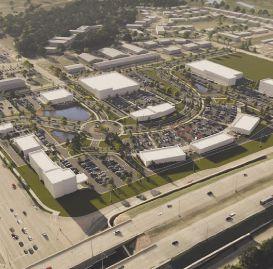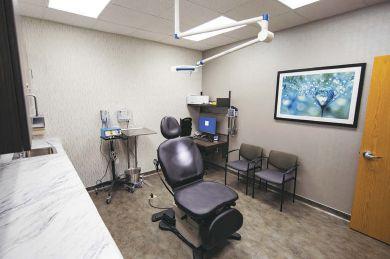
10 minute read
The multiplier effect
How university research can generate statewide economic growth
By Tom Dennis
GRAND FORKS, N.D. – In 1913, Edward W. Davis – a newly hired professor at the University of Minnesota School of the Mines –took a rock sample into the Mines Experiment Station “and did a little work on it,” he later wrote.
“It was a hard rock, mottled in appearance, with a few narrow bands of darker material passing through it.
“After breaking the sample into small pieces, I found that most of them could be picked up readily with a hand magnet.”
And from that observation in a U of M minerals lab, an industry and regional lifeline were born. For the rock Davis hammered was taconite. Iron miners had long discarded the low-grade ore.
But using magnets, Davis and other researchers found a way to pull iron out of crushed taconite. Then they baked the iron-rich powder into pellets.
The process turned waste rock into high-grade iron-ore pellets ready for shipment. Not coincidentally, it also saved the Minnesota Iron Range, creating a $1.8 billion-a-year industry that has kept the Range ranging for more than 60 years.
That’s the difference university research can make to a state’s economy, said Jay Kiedrowski, senior fellow in leadership and management at the U of M’s Humphrey School of Public Affairs.

And that’s the process lawmakers in North Dakota, South Dakota and Minnesota should remember when it comes to supporting research.
“One of the strongest ways to promote economic development is to have discoveries made in your state, and then have business people take those discoveries and turn them into products,” said Kiedrowski, formerly executive vice president for Wells Fargo, budget director for the city of Minneapolis and commissioner of finance for Minnesota.
“It’s research that has the economic multiplier effect,” he said, and so gives such a big bang for the taxpayers’ buck.
The question of whether university activity can have statewide economic impact is especially relevant in North Dakota. That’s where the presidents of the University of North Dakota and North Dakota State University are asking the state to invest $100 million in research – to be monitored by the Bank of North Dakota – at the campuses over a four-year period.


The word “research” is the key, Kiedrowski said. And the two presidents are smart to focus on it.
Universities have other statewide impacts, such as training a workforce. So, the presidents could have called for the state to spend money to lower tuition.
But while that would be great for students, “it wouldn’t produce the research that really could move the state forward,” he said.
Technology Advantage® Plus reduces the cost of monthly technical support, by having a scheduled Onsite PC Technician. Use in conjunction with a Technology Advantage® contract or ala carte. It is a great way to keep to a monthly budget and take care of any Tier 1 issues that may arise.

Examples of what Technology Advantage® Plus can do for you:

• PC Installs/Imaging of Desktops
• PC Virus Scans/Removals
• PC Maintenance
• PC Applications Installs
• Microsoft® Application Support
• Work with 3rd party application support for troubleshooting
• User VPN Configuration/Support
• Email Administration
• Active Directory Administration
• Outlook Issues
• Password Resets
• New User Set-up
• Printer Installs/Connectivity/Troubleshooting
• Permissions/Mapping Drives for Users
• ISP Issues
Commit to an Onsite Service PC Technician and take care of the issues right away.
For more information on Technology Advantage® Plus, you can reach us at 701-893-4000 • www.gocorptech.com • 2000 44th Street SW, Ste 100 Fargo, ND • 58103
©2018 Corporate Technologies, LLC
Another story from Minnesota: In 1952, University of Minnesota physicians conducted the first successful open-heart surgery. In 1957, a heart patient died when a power blackout shut down the patient’s pacemaker, which had been plugged in to the wall.
So, the U of M surgeon asked Earl Bakken, a U of M-trained engineer, to create a wearable, external, battery-operated pacemaker.
The company that resulted – Medtronic – now is one of the largest producers of medical devices in the world.
“That’s another example of how university research can have a dramatic impact,” Kiedrowski said.
North Carolina’s counter-example
Don’t misunderstand. There are no slam dunks in development, and that includes university research.
“Six decades ago, North Carolina banked on its research universities to revive its economy,” begins a 2017 story in the Chronicle of Higher Education.
“The plan worked, but it left much of the state behind.”
As the story recounts, North Carolina focused on creating a research park to serve the state’s three research universities. It worked; and as Research Triangle Park has succeeded, the college towns of Raleigh, Durham and Chapel Hill have thrived.
The trouble is, that prosperity never spread to rural North Carolina, much of which remains depressingly poor.
So, should Williston, N.D., and other western communities worry that Eastern North Dakota’s college towns will prosper at their expense?
No, and here’s why, said Dean Bresciani, NDSU president and a former senior administrator at the University of North Carolina at Chapel Hill.
First, a big difference is tobacco, traditionally the backbone of North Carolina’s farm economy. As the Research Triangle prospered, the tobacco economy tanked.

And unlike the transition on Minnesota’s Iron Range, no breakthroughs arose to replace that old industry with something new.
Second, UND and NDSU’s proposal would focus on exactly those kinds of breakthroughs, Bresciani said.
That’s why the Bank of North Dakota is involved – to play the role of monitor and referee.
UND President Mark Kennedy agreed. “At UND, for example, our No. 1 area in terms of funded research dollars is energy,” he said.
“When we get one more percentage point of extraction out of shale, it’s a $3 billion impact to the economy that primarily benefits the West.”
That’s the kind of work the universities would pursue, and the kind of results they’d be looking for, he said.
Mr. Taconite at the Legislature
Let’s close with one more tale about “Mr. Taconite,” Edward W. Davis of the University of Minnesota. This one’s from the website of the Natural Resources Research Institute in Duluth; and it shows that UND and NDSU’s presidents aren’t the first to lobby lawmakers about the statewide value of research.
The story starts with a quote:
“‘Geologists tell us that nature laid down the taconite here on the Range a billion years ago.
“‘The next day, Ed Davis started trying to sell it to the steel companies.’



“The state legislator who spoke those words in the 1940s was growing weary of University of Minnesota researcher Edward W. Davis,” the NRRI’s website recounts.
“Every two years, he’d show up in St. Paul asking for continued research funding to develop low grade taconite into a viable product for steel production. But without Davis’s dogged persistence, the Iron Range would not, truly could not, have continued to supply U.S. steel producers with iron ore all these decades to come.”







PRESIDENT
WHERE ARE YOU FROM, AND HOW DID YOU GET STARTED WITH PRAXIS? Q.
A.
I’m originally from Grand Forks, and that’s how I wound up here. I grew up here, went to high school here, went to college here at UND.
What happened is that I started to work with Delore Zimmerman, Praxis Strategy Group’s co-founder, in the late 1990s as I was finishing my business degree. I was doing an internship in Denver, and he had started another company that was moving to that area from Grand Forks.
Q. A.
Schill has close to 20 years of experience in economic analysis and demographic research, and has worked on development strategies for cities in 13 states.

In this Q&A, he talks about his work as well as the strengths and weaknesses of cities in our region.
DID YOU SET OUT TO BE A CONSULTANT OR PLANNER?
Not at all. It’s interesting, because working in economic development, strategic planning or policy research in general is not something you think about when you’re in high school or college.
Instead, getting involved in a field like this is often just serendipity. You see an opportunity, and you work to develop it as well as acquire the necessary skills.
And I’ve been fortunate to get involved in this field as the internet became available, and information and data just became so much more accessible.
As a result, today you can train yourself on virtually any skill that you need in terms of the work you do.
When it comes to careers, I’ve always thought, “Just get caught in the act of doing something.” Don’t be afraid to experiment – to say yes to something, even if you may not have a clear road map of how to do it. You can’t know until you try.
Q. A.
HOW ABOUT NEWGEOGRAPHY.COM, WHICH YOU HELP EDIT? HOW DID THAT COME ABOUT?
Basically, it was the same kind of thing. We started that with Joel Kotkin, whom Delore has known ever since the two of them were fellows for the Center for the New West in Denver in the 1990s. ( Editor’s note: Kotkin is a California-based author who writes for a national audience about economic, demographic and social trends.)
At the time, Joel had a monthly column, and I got to know him through that connection; I did a lot of research for him. It slowly evolved until about 10 years ago. At the time, Joel was seeing the wholesale changes in the media industry as he knew it, especially the fragmentation and the downsizing.
And we thought, why not build our own platform?
So, the website was literally built in my basement. It was one of those things where we said, hey, we need to build this, we don’t have a lot of money, so let’s just try to do it ourselves.
And again, a lot of it is serendipity, with all of this happening at what proved to be the right time to get into a field like this.
We can be a firm like ours, we can work publishing a website with a partner in Los Angeles, and it’s really not a problem. At Praxis, our largest clients for many years were in Washington, and here we are in Grand Forks – and it turns out that works just fine.
Q. A.
YOU’VE DONE LOTS OF CONSULTING FOR CITIES AROUND THE REGION. WHAT KINDS OF CHANGES HAVE YOU SEEN?
Economic development has really evolved from 30 or 40 years ago, when it was all about huge incentive programs. Today, economic development agencies are finding themselves as one of the few in the community whose mission is just general prosperity and economic wellbeing.
That means that these days, a big part of planning is to help strengthen the networks in a community, which ultimately strengthens trust. Because as communities and economies evolve, the strength of the economy comes more and more to depend on the strength of those networks.
Providing medications to patients efficiently and safely is what matters.
With LEAN work processes and functional workplace design, pharmacists can prepare and deliver medications to patients quickly, accurately, and safely.


WHAT DO YOU MEAN? Q.
A.Think about Sioux Falls, S.D. Sioux Falls is one of the most interesting examples of urban success anywhere, because remember: in general, the small cities with a major university or a state Capitol or both have done very well. But Sioux Falls has neither of those.
If you look at it in that way, you see that there really is no concrete competitive advantage.
Instead, Sioux Falls is one of the best examples of a community that has succeeded because of its networks and its broad, sound fundamentals – good schools, good amenities and so on.
It’s just a nice place to live. And over the past 15 years, it has really improved the quality of its arts and culture, the quality of its restaurants. It’ll never compete with a large metro area, but it’s a lot closer than it once was.
That’s no accident.
HOW SO? Q.
Because one of the biggest things we’ve seen is – and it goes back to that intangible sense of community – Sioux Falls does planning really well.
Every five to eight years, they renew their strategic plan and their sense of direction. Almost no other place does that; but in Sioux Falls, it’s part of their civic DNA.
This really hit me when we had a client one time that was investigating land prices in various industrial parks. And we found that when we started calling around Sioux Falls, no matter which community we called, they said, “Look, if you don’t come to our town, come to the next town over. Come to the region.”
They had this sense of regionality and cooperation that was really impressive.
It’s the will for everyone to work together for the benefit of making community investments. That’s the difference. You always can come up with great ideas, but getting to the point where everyone’s willing to support those investments and these projects – that’s the key.
HOW ABOUT OTHER CITIES AND THE EXAMPLES THEY PROVIDE? Q.
Q.WOULD YOU SAY DULUTH IS A PLACE WITH POTENTIAL AND GREAT OPPORTUNITIES?
A.Absolutely, because it has unprecedented amenities. And it has colleges and universities, and to be frank, comparatively cheap housing.
That’s part of what fueled Fargo’s growth for so long, after all. Say what you will about the sprawl that it generated, but in Fargo, having relatively affordable housing along with job growth really mattered. If you can buy a home when you’re 25 years old, that really helps upward mobility as well.
IT MUST BE FUN TO WATCH AND TRACK ALL OF THESE CHANGES. Q. A.
It is, and it’s great to watch how even the fundamental demographics of our region evolve.
North Dakota, for instance, now is in the top five youngest states, and that fundamental restructuring of the age demographics in this region is really important.
The net result is that our cities are in a “sweet spot” in many ways, including size. Besides their good schools and other amenities, they’ve got a critical mass of business people and others who can engage in ways that can get things done.
In short, these are well-run communities that are fundamentally sound, and that has dramatically changed the outlook for the region. It’s no longer just a long-term narrative of decline.
A.Whether it’s making investments in the Main Street Square in downtown Rapid City, S.D., or the Greenway in Grand Forks, successful communities are recognizing the value of amenities and of quality arts and culture.
Another great example is in Rochester, Minn.; the same thing has happened there.
In the early 2000s, downtown Rochester was fairly derelict. There wasn’t a lot there other than a handful of small and longestablished restaurants.
But even in the past five years, that has dramatically changed. Part of that is because of the concrete and massive investment of the Destination Medical Center strategy, but part of it also is fueled by the shift toward people recognizing the value of the local culture and local flavor.
Now, here’s an example from another direction: Duluth. Because when you compare Duluth’s economy with the economies of a Fargo or a Sioux Falls, you find that Duluth lags significantly on a lot of the core measures of economic growth.
But remember, Duluth is an entirely different economy; it’s tied to the Great Lakes economy, not the Great Plains economy. So it’s radically different – much more Rust Belt than Grain Belt.









